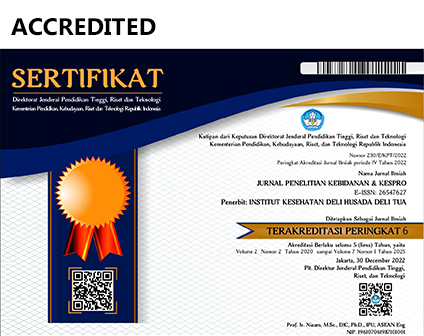PERBEDAAN STATUS GIZI PADA BALITA DENGAN ASI EKSKLUSIF DAN TANPA ASI EKSKLUSIF DI DESA KLOMPANGAN KABUPATEN JEMBER
Abstract
Babies who get exclusive breastfeeding will have optimally nutritionis then made them healthier, having better self devense from repeated infectious,not so easily getting allergies and sickness. For the results, babies whoget exclusively breastfeeding will grow and develop betterand optimal. The growthcan be observed from height, weight, etc. While optimal development observed from increasing motoric, psychomotoric and language. The aim of this research was to find the deferences between toddlers with and without exclusive breastfeeding in the Klompangan village Jember district.
This research used comparative study by Cross Sectional approach. The respondent was 98 babies from simple random sampling, with colledted data by questioner and health indicator book. Bivariate was done by T test with p value < 0.05.
This study showed that the majority of children's nutritional status was in good category with exclusive breastfeeding. After the T test was carried out, the P value (Sig. 2 tailed) was 0.000, because P-value > (α = 0.05), which meant that there was difference in not significant the nutritional status of toddlers with breastfeeding and without breastfeeding in the Klompangan village Jember district.
Remembering how important of exclusive Breastfeeding it is hoped to expectant and new moms to give exclusive breastfeeding of to their babies 6 months for minimum and continuins to 2 years if it is possible.
References
Fitri, D. I., Chundrayetti, E., & Semiarty, R. (2014). Hubungan Pemberian ASI dengan Tumbuh Kembang Bayi Umur 6 Bulan di Puskesmas Nanggalo. Jurnal Kesehatan Andalas, 3(2). https://doi.org/10.25077/jka.v3i2.51
Kementrian kesehatan. (2017). Pedoman Penyelenggaraan Pekan ASI.
Marimbi, H. (2013). Tumbuh Kembang, Status Gizi dan Imunisasi Dasar Pada Baduta. Nuha Medika.
Nikmatul, Q. (2016). Pengetahuan, Sikap, Dan Praktik Dalam Pemberian ASI Eksklusif Di Wilayah Kerja Puskesmas Rembang 2 Dan Puskesmas Sarang. Jurnal Kesehatan Masyarakat (e-Journal), 4(1), 249–256.
Notoatmodjo. (2013). Metode Penelitian Kesehatan. Rineka Cipta.
Parti, 2020. Hubungan Pemberian ASI Eksklusif dengan status gizi bayi usia 6-12 bulan. Diakses Tanggal 22-9-2022
Purwoko. (2013). Hubungan Pengetahuan dan Sikap dengan Status Kesehatan Gigi pada Anak Sekolah Dasar di Wilayah Kerja Puskesmas Sawit I.
Rahmi, P. (2019). Peran Nutrisi Bagi Tumbuh dan Kembang Anak Usia Dini. Jurnal Ar-Raniry. https://jurnal.ar-raniry.ac.id/index.php/bunayya/...
Sastroasmoro, S. (2013). Dasar-Dasar Metodologi Penelitian Klinis. Sagung seto.
Selvi Nopianti, Atti Yudiernawati, A. J. K. (2017). Perbedaan Status Gizi Bayi yang Mendapatkan ASI Eksklusif Ibu dengan Indeks Masa Tubuh (IMT) yang berbeda di Posyandu Mawar Tlogomas Probolinggo. Nursing News, 2(3), 21–33. https://publikasi.unitri.ac.id/index.php/fikes/article/view/450/368
Susilowati. (2016). Gizi dalam Daur Kehidupan. PT Refika Aditama.
Swarjana, I. ketut. (2016). Statistik Kesehatan. Penerbit Andi.
Syahdrajat, T. (2015). Panduan Menulis Tugas Akhir Keadaan Kesehatan Ed. I. Pranadamedia group.
Wati, 2016. Perbedaan status gizi bayi yang diberi ASI Eksklusif dengan tidak diberi ASI eksklusif. Diakses tanggl 22-9-2022
WHO. (2021). Infant and young child feeding. WHO. https://www.who.int/news-room/fact-sheets/detail/infant-and-young-child-feeding
Yuliana, & Melyani. (2018). Perbedaan Status Gizi Antara Bayi Usia 0-6 bulan dengan Pemberian ASI secara Eksklusif dan Tidak Secara Eksklusif di Puskesmas Kampung Dalam Tahun 2018. Jurnal Kebidanan, 9.
Yustianingrum, 2020. Perbedaan Status gizi dan penyakit infeksi pada anak baduta yang diberi ASI Eksklusif dan Non ASI Eksklusif. Diakses Jurnal tanggal 22-9-2022. https://e-journal.unair.ac.id/AMNT/article/view/7128








